The Royal Netherlands Navy is the naval force of the Kingdom of the Netherlands. It is one of the four Netherlands Armed Forces. It was founded on 8 January 1488, making it the third-oldest naval force in the world.

HNLMSBuffel is a 19th-century ironclad ram ship. She was one of the main attractions of the Maritime Museum Rotterdam, also known as the Prince Hendrik Museum, named after its founder, Prince Henry (Hendrik) "The Navigator", who had a naval career and established the basis of the museum back in 1874. In October 2013 the ship moved to Hellevoetsluis and is again open for public.
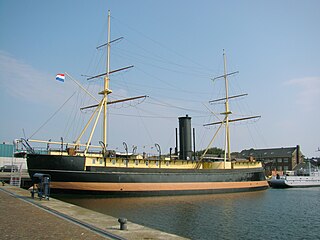
HNLMS Schorpioen is a Schorpioen-class monitor built in France for the Royal Netherlands Navy in the 1860s. These new ships were equipped with heavy rifled 23 cm (9 in) guns, and a heavy armor. The hull had an armor plated belt of 15 cm (6 in) and the gun turret, housing the two guns, had almost 30 cm (12 in) of armor.

De Kooy Airfield is an airfield 2.9 NM south of Den Helder, Netherlands, named after the nearby hamlet De Kooy. It serves as both a civilian airport under the name Den Helder Airport and a naval airport under the name Maritiem Vliegkamp De Kooy.

HNLMSBonaire is a Samarang-class gunvessel of the Royal Netherlands Navy, now under restoration as a museum ship.
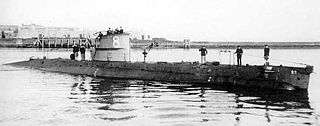
HMS H6 was a British H-class submarine of the Royal Navy built by Canadian Vickers & Co. during World War I.

The Royal Netherlands Navy Submarine Service is a department within the Royal Netherlands Navy that is responsible for the deployment of Dutch submarines. It was established out of the Netherlands Torpedo Service on 21 December 1906, and merged with the Netherlands Mine Service on 15 July 2005.

Vice admiral Matthieu Borsboom is a retired Royal Netherlands Navy officer who is a former Commander of the Royal Netherlands Navy and Admiral Benelux, and has served with the International Security Assistance Force in Afghanistan.

HNLMS O 12 was a O 12-class submarine of the Royal Netherlands Navy. Built at Koninklijke Maatschappij De Schelde in Vlissingen, she was launched in 1930 but was unable to take part in military action during World War II. After being scuttled by the Dutch Navy, she was raised by Nazi Germany's Kriegsmarine and taken into service as UD-2, and then scuttled again.

HNLMS Tonijn was a Potvis-class submarine of the Royal Netherlands Navy.
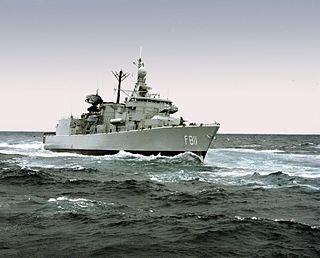
HNLMS Piet Hein (F811) was a frigate of the Kortenaer class. The ship was in service with the Royal Netherlands Navy from 1981 to 1998. The frigate was named after Dutch naval hero Piet Pieterszoon Hein. The ship's radio call sign was "PAVM".

HNLMS Dolfijn (S808) is a Walrus-class submarine of the Royal Netherlands Navy. She entered service in 1993 as the third submarine of the Walrus class, after HNLMS Walrus and HNLMS Zeeleeuw. Dolfijn has been deployed both for naval exercises and in combat operations around the world. Furthermore, the submarine plays an important role by performing intelligence operations.

HNLMS Onverschrokken (A856), also known as HNLMS Mercuur (A856), was an Onversaagd-class minesweeper of the Royal Netherlands Navy (RNN). Soon after being taken into service of the RNN, the ship was put into reserve alongside the rest of the minesweepers of the Onversaagd class. Later, in 1973 she was renamed as HNLMS Mercuur (A856) and used as submarine support ship till her decommissioning in 1987. Nowadays, she is a museum ship that can be visited in Vlissingen.
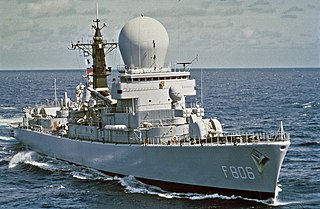
HNLMS De Ruyter (F806) was a frigate of the Tromp class. The ship was in service with the Royal Netherlands Navy from 1976 to 2001. The frigate was named after Dutch naval hero Michiel de Ruyter. The ship's radio call sign was "PAEP".

HNLMS A was an A-class minesweeper of the Royal Netherlands Navy that was scuttled by her crew during the Battle of Java. She was later re-floated and repaired by the Japanese and converted into auxiliary submarine chaser Cha-113 or No. 113.

HNLMS Den Helder is a new replenishment oiler under construction for the Royal Netherlands Navy. Also known as the Combat Support Ship (CSS), Den Helder is planned to fill the gap of replenishment at sea that was left after HNLMS Amsterdam was sold to Peru in 2014.
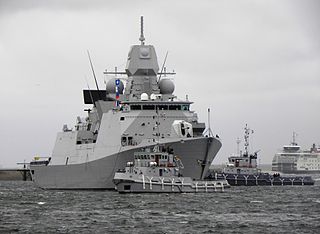
The Linge class are a series of tugboats used by the Royal Netherlands Navy to dock their larger ships at the Nieuwe Haven Naval Base.
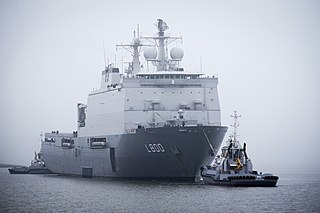
The Noordzee class are a class of tugboats used by the Royal Netherlands Navy to dock their larger ships at the Nieuwe Haven Naval Base.
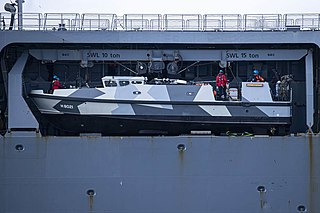
HNLMS Hydrograaf (H8021) is a expeditionary survey boat (ESB) of the Royal Netherlands Navy.
HNLMS Wambrau (A871) was a tugboat of the Royal Netherlands Navy (RNN). She served in the RNN between 1957 and 1987.



















